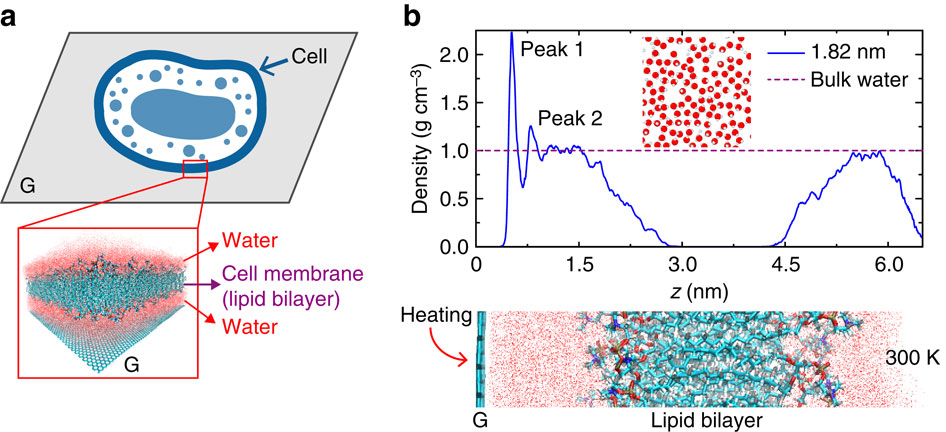当前位置:
X-MOL 学术
›
Nat. Commun.
›
论文详情
Our official English website, www.x-mol.net, welcomes your feedback! (Note: you will need to create a separate account there.)
Intercalated water layers promote thermal dissipation at bio-nano interfaces.
Nature Communications ( IF 14.7 ) Pub Date : 2016-Sep-23 , DOI: 10.1038/ncomms12854 Yanlei Wang , Zhao Qin , Markus J. Buehler , Zhiping Xu
Nature Communications ( IF 14.7 ) Pub Date : 2016-Sep-23 , DOI: 10.1038/ncomms12854 Yanlei Wang , Zhao Qin , Markus J. Buehler , Zhiping Xu

|
The increasing interest in developing nanodevices for biophysical and biomedical applications results in concerns about thermal management at interfaces between tissues and electronic devices. However, there is neither sufficient knowledge nor suitable tools for the characterization of thermal properties at interfaces between materials of contrasting mechanics, which are essential for design with reliability. Here we use computational simulations to quantify thermal transfer across the cell membrane-graphene interface. We find that the intercalated water displays a layered order below a critical value of ∼1 nm nanoconfinement, mediating the interfacial thermal coupling, and efficiently enhancing the thermal dissipation. We thereafter develop an analytical model to evaluate the critical value for power generation in graphene before significant heat is accumulated to disturb living tissues. These findings may provide a basis for the rational design of wearable and implantable nanodevices in biosensing and thermotherapic treatments where thermal dissipation and transport processes are crucial.
中文翻译:

插入的水层促进了生物-纳米界面的散热。
对开发用于生物物理和生物医学应用的纳米器件的兴趣日益浓厚,这引起了人们对组织和电子器件之间界面热管理的担忧。但是,对于对比力学的材料之间的界面处的热特性的表征,没有足够的知识,也没有合适的工具,这对于可靠地进行设计是必不可少的。在这里,我们使用计算模拟来量化跨细胞膜-石墨烯界面的热传递。我们发现,插层水在〜1 nm纳米约束的临界值以下显示出分层顺序,介导了界面热耦合,并有效地增强了散热。此后,我们开发了一个分析模型,以评估在积聚大量热量以破坏生物组织之前石墨烯发电的临界值。这些发现可能为合理设计生物传感和热疗中可穿戴和植入式纳米设备的基础,在这些设备中,散热和传输过程至关重要。
更新日期:2016-09-25
中文翻译:

插入的水层促进了生物-纳米界面的散热。
对开发用于生物物理和生物医学应用的纳米器件的兴趣日益浓厚,这引起了人们对组织和电子器件之间界面热管理的担忧。但是,对于对比力学的材料之间的界面处的热特性的表征,没有足够的知识,也没有合适的工具,这对于可靠地进行设计是必不可少的。在这里,我们使用计算模拟来量化跨细胞膜-石墨烯界面的热传递。我们发现,插层水在〜1 nm纳米约束的临界值以下显示出分层顺序,介导了界面热耦合,并有效地增强了散热。此后,我们开发了一个分析模型,以评估在积聚大量热量以破坏生物组织之前石墨烯发电的临界值。这些发现可能为合理设计生物传感和热疗中可穿戴和植入式纳米设备的基础,在这些设备中,散热和传输过程至关重要。














































 京公网安备 11010802027423号
京公网安备 11010802027423号